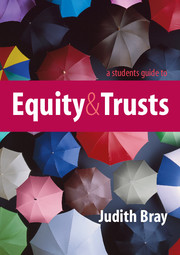Book contents
- Frontmatter
- Contents
- Preface
- 1 Historical introduction
- 2 Equitable remedies
- 3 The classification of trusts and powers
- 4 The three certainties
- 5 Constitution of trusts
- 6 Formalities for the creation of a trust
- 7 Private purpose trusts
- 8 Unincorporated associations
- 9 Resulting trusts
- 10 Constructive trusts
- 11 Trusts of the family home
- 12 Secret trusts and mutual wills
- 13 Charities; the Charities Act and the rules of cy près
- 14 Trustees: appointment, retirement and capacity
- 15 Duties and powers of trustees
- 16 Variation of trusts
- 17 Fiduciary duties and breach of fiduciary duties
- 18 Breach of trust and defences to breach of trust
- 19 Remedies against strangers to a trust
- 20 Tracing
- Index
16 - Variation of trusts
- Frontmatter
- Contents
- Preface
- 1 Historical introduction
- 2 Equitable remedies
- 3 The classification of trusts and powers
- 4 The three certainties
- 5 Constitution of trusts
- 6 Formalities for the creation of a trust
- 7 Private purpose trusts
- 8 Unincorporated associations
- 9 Resulting trusts
- 10 Constructive trusts
- 11 Trusts of the family home
- 12 Secret trusts and mutual wills
- 13 Charities; the Charities Act and the rules of cy près
- 14 Trustees: appointment, retirement and capacity
- 15 Duties and powers of trustees
- 16 Variation of trusts
- 17 Fiduciary duties and breach of fiduciary duties
- 18 Breach of trust and defences to breach of trust
- 19 Remedies against strangers to a trust
- 20 Tracing
- Index
Summary
Key points
once a trust is fully constituted the trustees are under a duty to carry out its terms;
the court has some jurisdiction to vary a trust under its inherent jurisdiction;
the court’s jurisdiction to vary is limited and only applies to a case of emergency or compromise;
a number of statutory provisions give limited power to vary the terms of a trust to the trustees;
the rule in Saunders v. Vautier gives the beneficiaries power to terminate the trust prematurely;
the right of the beneficiaries to terminate the trust depends on whether they are all of age, in agreement and together are fully entitled to the property;
the Variation of Trusts Act 1958 gives the court wide powers to vary a trust but only where a benefit is derived;
the powers of the court to vary under the Variation of Trusts Act extends to unborn and minor beneficiaries; and
a variation will not be approved if it is deemed to be a complete resettlement of the trust property.
Introduction
Once a trust is fully constituted the terms are binding on the trustees and the provisions of the trust must be carried out as set out by the settlor. If a trustee does not carry out the terms as set out in the trust instrument, he/she would be vulnerable to an action for breach of trust. However there has always been some limited scope to vary the terms of a trust usually in the event of an unforeseen event arising.
The court holds inherent jurisdiction to vary the terms of a trust in certain circumstances but this jurisdiction is limited.
There were several statutory provisions to vary a trust even before the Variation of Trusts Act 1958 was introduced.
Although strictly not usually a variation the beneficiaries could always combine together and bring the trust to an end under the rule in Saunders v. Vautier (1841) 4 Beav 115.
- Type
- Chapter
- Information
- A Student's Guide to Equity and Trusts , pp. 263 - 283Publisher: Cambridge University PressPrint publication year: 2012



